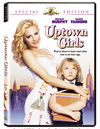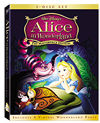Software Reviews
 DVD: Uptown Girls—MGM/UA
DVD: Uptown Girls—MGM/UAVideo: 4
Audio: 4
Extras: 3
Eight-year-old Ray (Dakota Fanning), the daughter of a wealthy but inattentive mom and a father on his deathbed, never had a proper childhood. Molly (Brittany Murphy), the suddenly penniless daughter of a deceased rock icon, seems to have never entered adulthood. When Molly is recruited as a nanny to the obsessively clean, wise-beyond-her-years girl, they both learn how to act their ages.
Comfortably predictable, and at times perfectly charming, Uptown Girls pulls all the right heartstrings, even as it glosses over the characters' back stories. While I could live happily without seeing another movie featuring Murphy's pouting mug, Fanning is remarkable as Ray. I swear, this nymph could read the phone book and get me choked up. At 10, she emotes like actresses three times her age.
The DVD is first-rate. The solid (1.85:1) anamorphic video presentation delivers the colorful production design with flair. While the Dolby Digital 5.1 soundtrack never really revs up in this dialogue-dependent movie, it's workmanlike and delivers nice ambiance for the many musical sequences.
Varied extras include a piece on the movie's costumes and a standard-issue making-of, in which Fanning and Murphy sing the praises of New York City as the perfect setting for what's essentially a fairy tale. There's also 18 minutes of deleted scenes, some of which clearly were cut to retain the film's PG-13 rating.
Although it may be contrived, this is a fairly respectable family film (although with some suggested sex) that wears its heart on its sequined sleeve.—Gary Frisch
 DVD: Alice in Wonderland—Buena Vista
DVD: Alice in Wonderland—Buena Vista
Video: 3
Audio: 4
Extras: 4
Alice in Wonderland is a true Disney classic; it's colorful, imaginative (even though it's Lewis Carroll's imagination at work), and musically charged. Gather all these elements into one film, and you've got a movie that delights children and reminds adults of the power of daydreams.
This Masterpiece Edition is quite appealing, visually, thanks to a striking 1.33:1 transfer. The colors are rich and vibrant. You'll notice some noise and artifacts here and there, but that's probably due more to the film's age than to the disc's quality. (Alice in Wonderland originally debuted in 1951.) Since this is a Disney film, you can imagine the importance of music in the movie. The Dolby Digital 5.1 surround catapults you into Alice's make-believe world of nonsense. You can hear the flowers' song, "Golden Afternoon," from every angle, and each different peep that Alice encounters in Tulgey Wood is represented nicely in each speaker.
Perhaps the best part of this edition, though, is the slew of extras you'll find in the two-disc set. From newly discovered songs (the Cheshire Cat's "I'm Odd"—yes, you are) and sing-along songs to deleted materials, Walt Disney's original TV introductions, and a set-top game, you could easily spend two hours exploring these two discs. A THX Optimizer helps you set up your theater so you get the most enjoyment from this film. Great family entertainment.—Amy Carter
 Bill Evans Trio—Portrait in Jazz (SACD, Riverside/Fantasy)
It was 1959 when Bill Evans navigated 88 keys through uncharted territory on Kind of Blue, the Miles Davis masterpiece, a magical touchstone of modern jazz. That same year he took a trio into the studio to record his own quietly brilliant third album. All the ingredients that made him a low-key giant are present on Portrait in Jazz.
Bill Evans Trio—Portrait in Jazz (SACD, Riverside/Fantasy)
It was 1959 when Bill Evans navigated 88 keys through uncharted territory on Kind of Blue, the Miles Davis masterpiece, a magical touchstone of modern jazz. That same year he took a trio into the studio to record his own quietly brilliant third album. All the ingredients that made him a low-key giant are present on Portrait in Jazz.
This hybrid release's SACD layer provides only a modest sonic improvement over the CD layer. Both layers are stereo only and neither suffers for it—no revisionism is needed here. The track lineup follows the 1987 CD release by providing extra takes of "Blue in Green" and "Autumn Leaves," with one version of the latter in mono. The difference becomes dramatic when Evans and his bassist Scott LaFaro begin soloing simultaneously. On the stereo version the piano is in the center and the bass at hard right. The mono release blends them, creating a much different spatial feeling (and with a different performance).
Despite a sprinkling of originals—one by Evans and one by Davis—the pianist used pop standards as the basis of his unfettered explorations in melody and phrasing. He's at his freest on Cole Porter's "What Is This Thing Called Love?" Rodgers and Hart's "Spring Is Here" is sad but serene, like a slow walk in the park on a cloudy day. For kicks, there's "Someday My Prince Will Come" from Disney's Snow White and the Seven Dwarfs. Some of your guests may mistake Evans' elegance and poise for cocktail-party jazz, but the connoisseurs will always know that they're listening to real music.—Mark Fleischmann
- Log in or register to post comments

























































